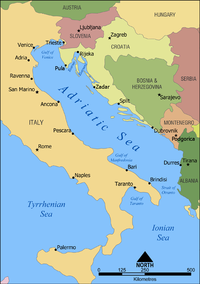
Photo from wikipedia
Simple Summary The seagrass Posidonia oceanica is the most important marine phanerogam of the Mediterranean Sea due to its meadows’ complexity, persistence, and extension. These habitats provide a suite of… Click to show full abstract
Simple Summary The seagrass Posidonia oceanica is the most important marine phanerogam of the Mediterranean Sea due to its meadows’ complexity, persistence, and extension. These habitats provide a suite of ecosystem goods and services, being of primary importance in marine conservation. Despite their central role in the coastal ecology, P. oceanica meadows are undergoing overall deterioration and fragmentation in the basin mostly due to anthropogenic impacts at local to global scales. In the last decades, several management measures have been proposed aiming to improve the meadow health conditions, while the periodic monitoring of P. oceanica meadows allows for verifying their effectiveness. Here, we report the results of the monitoring of P. oceanica at Tremiti Islands Marine Protected Area (Adriatic Sea, Italy) carried out in 2003, 2015, and 2020. A general worsening was observed, particularly enhanced by direct anthropogenic impacts mostly related to anchoring practices, as well as by a certain level of sedimentation possibly deriving from coastal development. However, the identification of these impacts and the correct management of human activities to mitigate them produced positive results in a relatively short time span. Abstract Posidonia oceanica meadows are Mediterranean coastal habitats of great conservation importance. This study is focused on a meadow located at Tremiti Islands Marine Protected Area (Adriatic Sea, Italy), which was monitored in 2003, 2015, and 2020 to evaluate its health state over time in relation to coastal human activities, which have been highly affecting this MPA for the last 20 years. To assess any change in the physiognomy of the meadow, rhizome density, percentage coverage, and lower limit progressions and/or regression over time were evaluated by scuba diving, while the distribution and extension of the meadow were assessed through habitat mapping using a side-scan sonar. Moreover, phenological and lepidochronological analyses were performed on the collected rhizomes to assess the leaf area index (LAI, m2m−2) and the rhizome age (lepidochronological years). Our study showed a general deterioration of P. oceanica meadow from 2003 to 2020, with a significant reduction of its absolute and relative rhizome density and LAI at almost all sampling stations, absence of renovation of the meadow, and lower limit regression and overall worsening of the main conservation status indicators. However, appropriate management actions, such as the establishment of mooring buoy fields, supported the improvement of the P. oceanica status at the local scale with a significant increase in density and LAI and the presence of active stolonization processes, suggesting that mitigation actions can play a crucial role in the conservation of this habitat. On the contrary, local anthropogenic impacts, especially anchoring and coastal development, markedly affect the resilience of P. oceanica meadows to global stressors, such as climate change.
Journal Title: Biology
Year Published: 2022
Link to full text (if available)
Share on Social Media: Sign Up to like & get
recommendations!